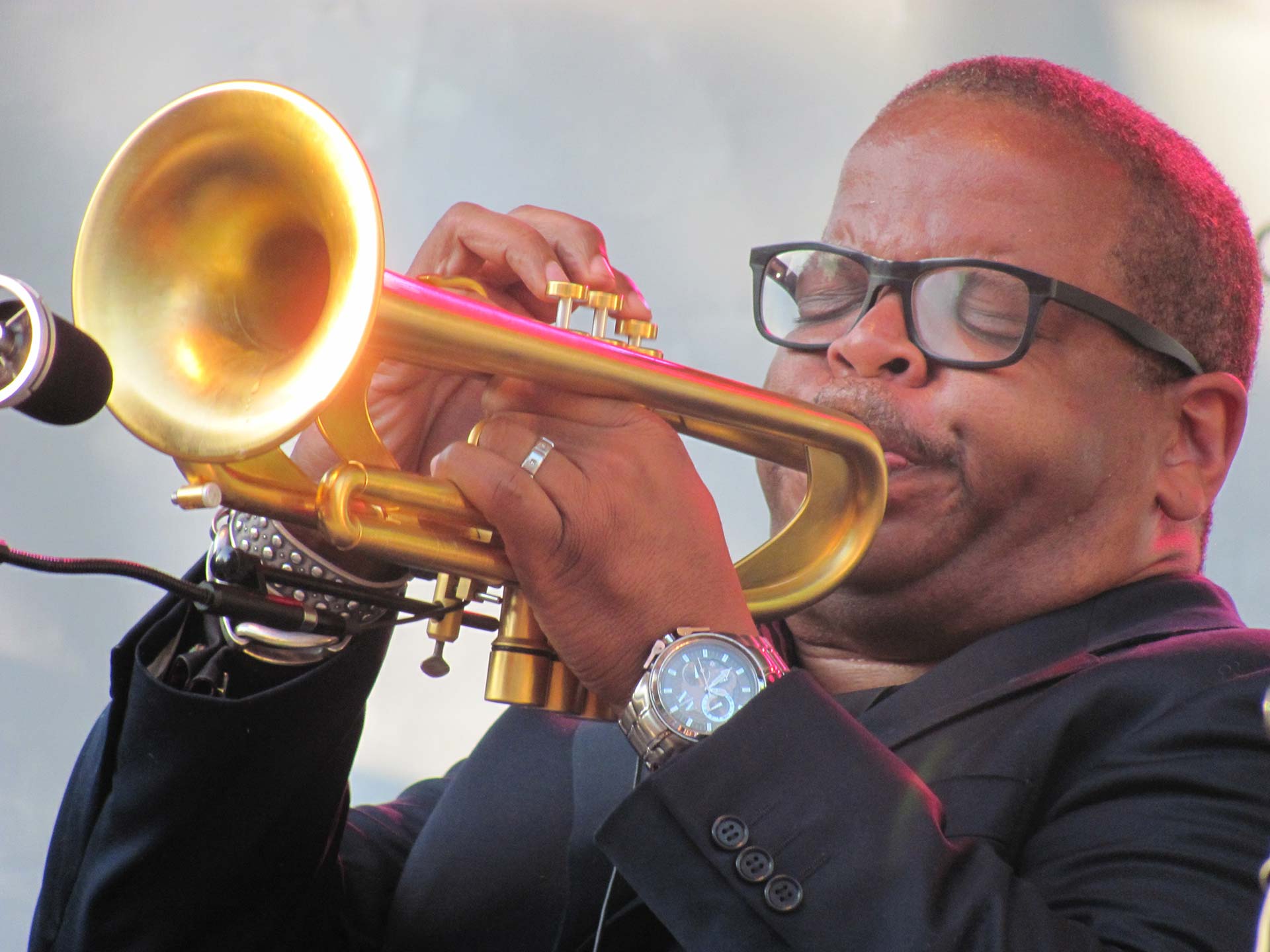It is widely accepted that the smile embouchure causes problems when playing. Most non professional players use the Zygomaticus Major, Buccinator and Risorius muscles of the cheek. Those muscles are used in making us smile. Some teachers use musical exercises called Buccinator Drills. That implies that those muscles should be used often.
Conversely a great many professional players frown and use the Depressor Labii Inferioris and Depressor Anguli Oris of the chin.


The purpose of this study was to document the differences between these two types of players and to provide evidence of which embouchure worked the best.
The methodology included the use of a thermal infrared camera, a decibel meter and a spectrum analyzer. A video camera was used to record all three of these devices as the subject played a multiple octave C scale.
The heat patterns of the players showed the muscle area in use. The heat ranges from blue, green, yellow, orange, red and finally white hot.
There were test subjects ranging from high school graduates up to players with Master of Performance degrees.
The smile players in these photos started out hotter in the cheek area on C4 than the frown players. The smile players only had 1 to 2 upper harmonics stronger than their C4. The frown players had 6 to 13 upper harmonics stronger than their C4.
A sudden flash of red in the cheek area of the subject caused the decibel meter to show a dramatic drop in power and volume. At the same time the spectrum analyzer would show a drop in the strength of the upper harmonics present in the sound. This flash of red indicated a sudden increase in muscle use in that area. The sudden heat changes in the smile players were usually when the player went from an open note to using valves while ascending. The frown players did not show the sudden heat change doing those note changes.
Conclusions were that the frown players had more range and resonance than the smile players. It showed that players should concentrate on using the muscles that were within 1.5 cm of the lips and around the chin. This study should encourage teachers to teach a frown embouchure to their students.
Supporting photographs
Still shots taken from video of 5 of my test subjects. 2 players had a range to G5 on top of the staff. One player had a range to G6. One player had a range to C7 and one player had a range to C8.

Player 1
Player 1 uses cheek muscles to play.



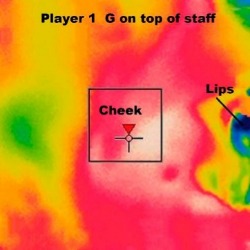
Player 2
Player 2 uses cheek muscles to play.

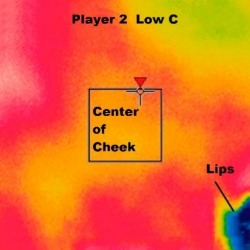


Player 3
Player 3 uses frown and a little cheek to play.




Player 4
Player 4 shows the heat buildup under the chin of a frown player.

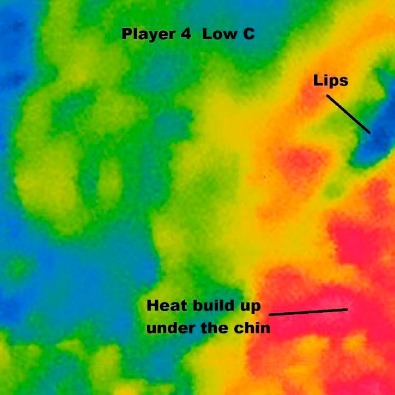
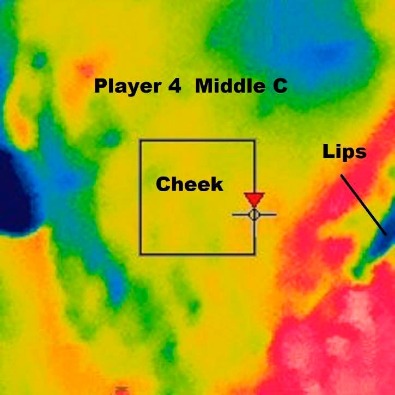

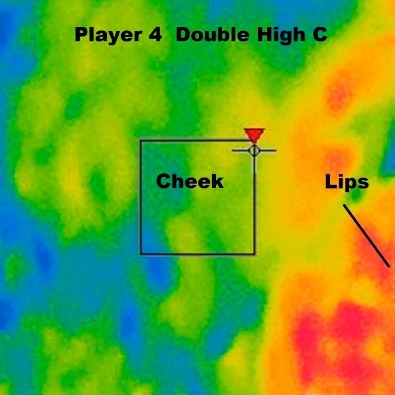
Player 5
Player 5 uses frown and adds some cheek muscles from C7 to C8.




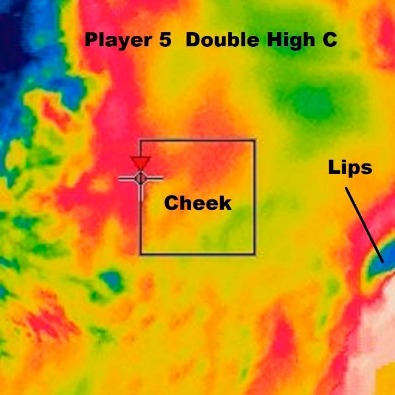

Conclusion
The investigation into the effects of utilizing cheek muscles versus chin muscles in trumpet playing has yielded valuable insights that can significantly impact the approach to embouchure technique. The prevailing notion of the smile embouchure, often relying on the Zygomaticus Major, Buccinator, and Risorius muscles of the cheek, has been challenged by the contrasting technique employed by numerous professional players who favor a frowning embouchure, engaging the Depressor Labii Inferioris and Depressor Anguli Oris of the chin.
This study employed advanced technology, including a thermal infrared camera, decibel meter, and spectrum analyzer, to objectively assess the performance of players adopting these different embouchures. The thermal images provided a visual representation of muscle activity, ranging from cooler hues to warmer tones, culminating in white-hot areas. The investigation involved a diverse range of subjects, from high school graduates to those holding Master of Performance degrees.
Notably, the findings indicated that players employing the frown embouchure exhibited superior range and resonance compared to their smile embouchure counterparts. The thermal images and corresponding analyses revealed that the muscle activity within 1.5 cm of the lips and around the chin was crucial for optimal trumpet performance. The frown players consistently demonstrated a more robust harmonic presence, with some exhibiting up to 13 strong upper harmonics, underscoring the effectiveness of this embouchure in achieving a resonant and powerful sound.
An intriguing observation was the occurrence of a sudden flash of red in the cheek area of smile players, coinciding with a noticeable drop in power, volume, and strength of upper harmonics. This phenomenon suggested that the smile embouchure might be susceptible to muscle tension issues, particularly during transitions from open notes to using valves while ascending.
In light of these findings, it is recommended that trumpet teachers consider emphasizing a frown embouchure in their instructional approaches. The supporting photographs further illustrated the thermal patterns associated with different embouchures, reinforcing the significance of muscle engagement around the chin for achieving optimal trumpet performance.
In conclusion, this study contributes valuable evidence supporting the efficacy of the frown embouchure in trumpet playing. Aspiring trumpeters and educators alike are encouraged to reflect on these findings and consider incorporating a frowning approach, recognizing its potential to enhance range, resonance, and overall musicality in the realm of trumpet performance.
